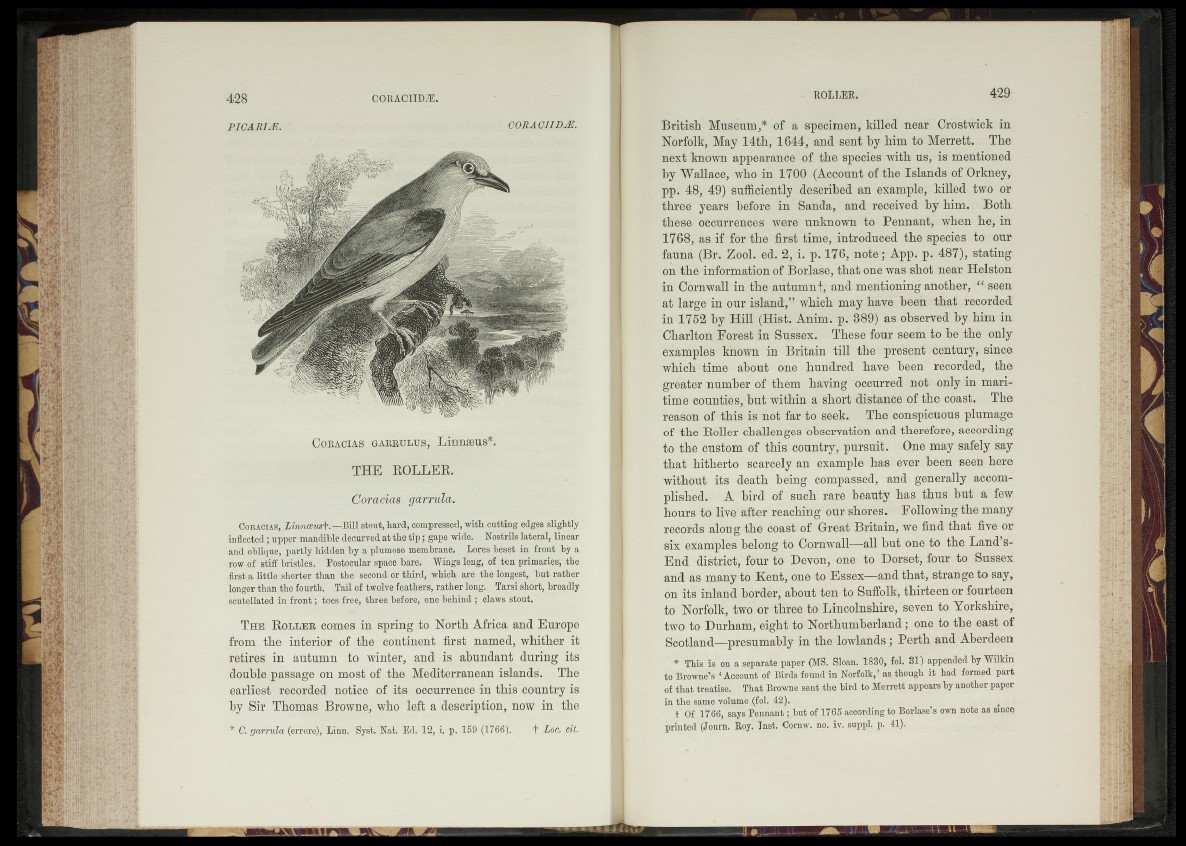
M Q A R IM . CORA Q IIBM .
Coracias garrulus, Linnaeus*.
THE ROLLER.
Coracias garrula.
Coeaoias, Linnaeusf .—Bill stout, hard, compressed, with cutting edges slightly
inflected; upper mandible decurved at the tip ; gape wide. Nostrils lateral, linear
and oblique, partly hidden by a plumose membrane. Lores beset in front by a
row of stiff bristles. Postocular space bare. Wings long, of ten primaries, the
first a little shorter than the second or third, which are the longest, but rather
longer than the fourth. Tail of twelve feathers, rather long. Tarsi short, broadly
scutellated in fro n t; toes free, three before, one behind ; claws stout.
The Roller comes in spring to North Africa and Europe
from the interior of the continent first named, whither it
retires in autumn to winter, and is abundant during its
double passage on most of the Mediterranean islands. The
earliest recorded notice of its occurrence in this country is
by Sir Thomas Browne, who left a description, now in the
* C. garrula (errore), Linn. Syst. Nat. Ed. 12, i. p. 159 (1766). t Loc. cit.
British Museum,* of a specimen, killed near Crostwick in
Norfolk, May 14th, 1644, and sent by him to Merrett. The
next known appearance of the species with us, is mentioned
by Wallace, who in 1700 (Account of the Islands of Orkney,
pp. 48, 49) sufficiently described an example, killed two or
three years before in Sanda, and received by him. Both
these occurrences were unknown to Pennant, when he, in
1768, as if for the first time, introduced the species to our
fauna (Br. Zool. ed. 2, i. p. 176, note; App. p. 487), stating
on the information of Borlase, that one was shot near Helston
in Cornwall in the autumn t, and mentioning another, “ seen
at large in our island,” which may have been that recorded
in 1752 by Hill (Hist. Anim. p. 389) as observed by him in
Charlton Forest in Sussex. These four seem to be the only
examples known in Britain till the present century, since
which time about one hundred have been recorded, the
greater number of them having occurred not only in maritime
counties, but within a short distance of the coast. The
reason of this is not far to seek. The conspicuous plumage
of the Roller challenges observation and therefore, according
to the custom of this country, pursuit. One may safely say
that hitherto scarcely an example has ever been seen here
without its death being compassed, and generally accomplished.
A bird of such rare beauty has thus but a few
hours to live after reaching our shores. Following the many
records along the coast of Great Britain, we find that five or
six examples belong to Cornwall—all but one to the Land s-
End district, four to Devon, one to Dorset, four to Sussex
and as many to Kent, one to Essex—and that, strange to say,
on its inland border, about ten to Suffolk, thirteen or fourteen
to Norfolk, two or three to Lincolnshire, seven to Yorkshire,
two to Durham, eight to Northumberland; one to the east of
Scotland—presumably in the lowlands; Perth and Aberdeen
* This is on a separate paper (MS. Sloan. 1830, fol. 31) appended by Wilkin
to Browne’s ‘Account of Birds found in Norfolk,’ as though it had formed part
of that treatise. That Browne sent the bird to Merrett appears by another paper
in the same volume (fol. 42).
t Of 1766, says Pennant; but of 1765 according to Borlase’s own note as since
printed (Journ. Roy. Inst. Comw. no. iv. suppl. p. 41).